Examining Whistleblowing: Case Studies, Ethics & Strategies
VerifiedAdded on 2022/11/18
|12
|2796
|386
Report
AI Summary
This report provides an overview of whistleblowing, defining it as the act of disclosing wrongdoing within an organization. It highlights the importance of whistleblowing for maintaining ethical standards and preventing illegal activities. The report includes three case studies: the Facebook Cambridge Analytica data scandal, drug trafficking at Sydney Airport, and whistleblowing within the National Security Agency (NSA). Each case study details the circumstances, the actions of the whistleblower, and the consequences faced. The report concludes with recommendations for organizations to address whistleblowing issues effectively, emphasizing the importance of strict rules, employee training, and creating a supportive environment for ethical disclosures. This document is available on Desklib, a platform offering a wide range of study tools and solved assignments for students.
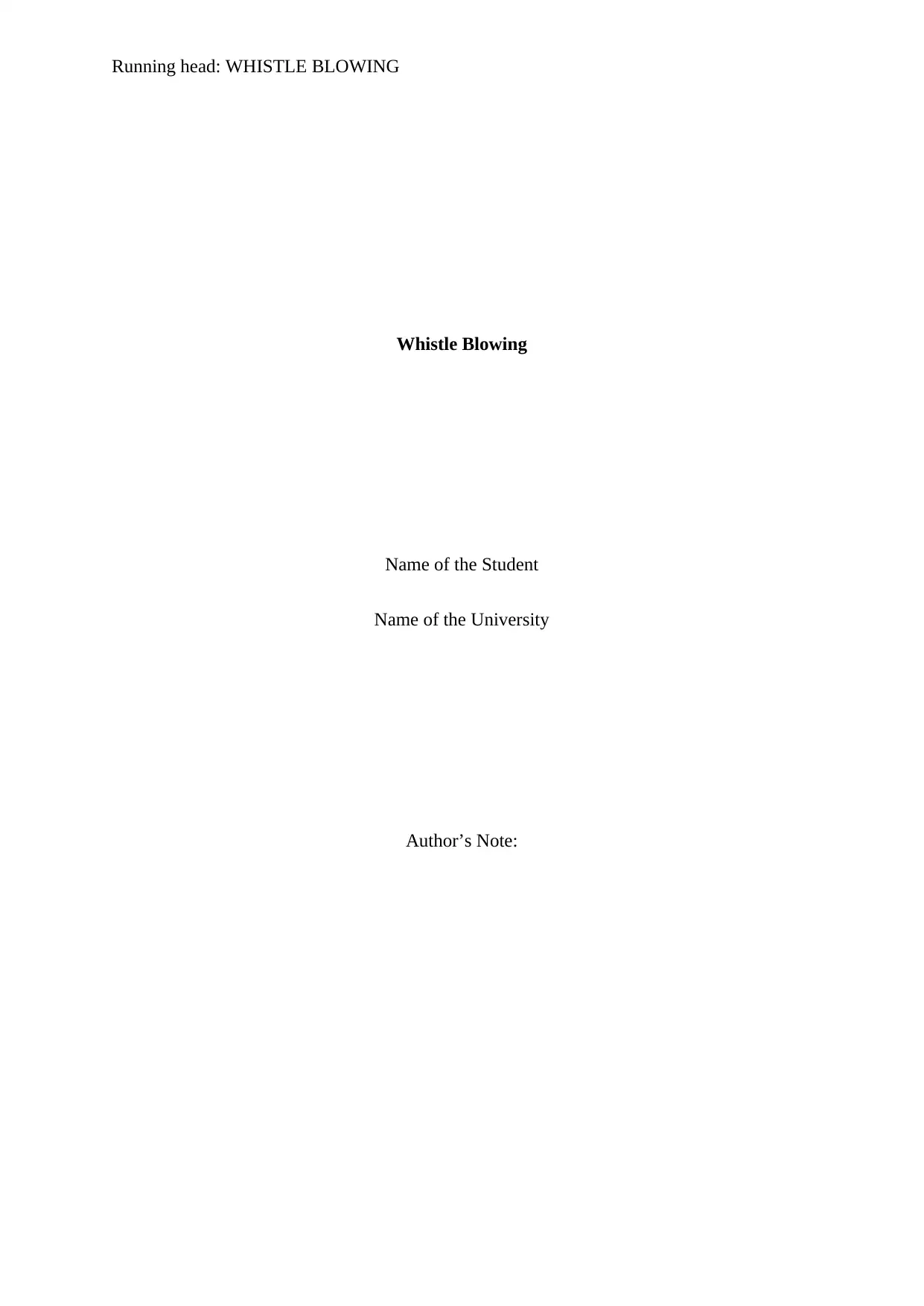
Running head: WHISTLE BLOWING
Whistle Blowing
Name of the Student
Name of the University
Author’s Note:
Whistle Blowing
Name of the Student
Name of the University
Author’s Note:
Paraphrase This Document
Need a fresh take? Get an instant paraphrase of this document with our AI Paraphraser
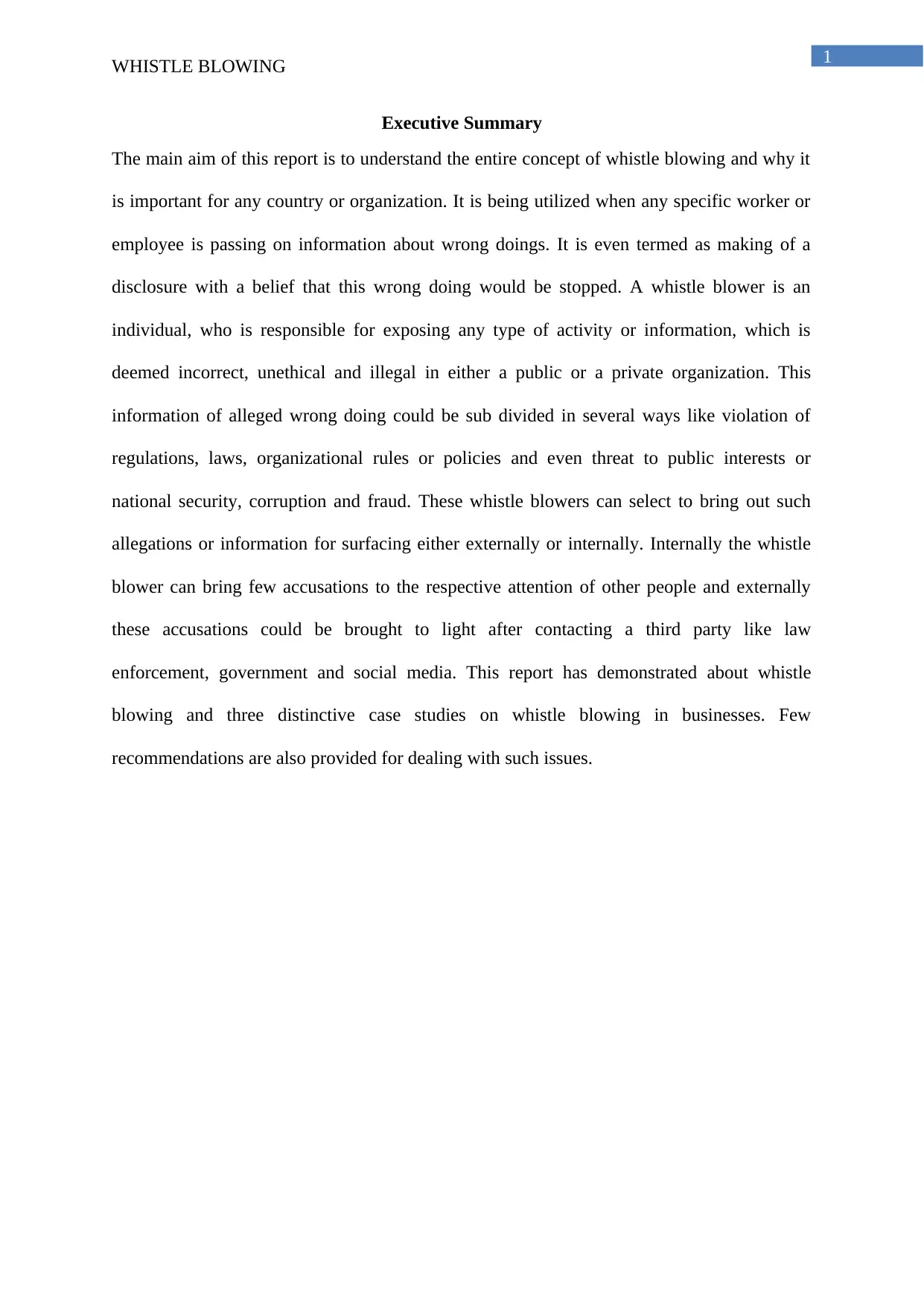
1
WHISTLE BLOWING
Executive Summary
The main aim of this report is to understand the entire concept of whistle blowing and why it
is important for any country or organization. It is being utilized when any specific worker or
employee is passing on information about wrong doings. It is even termed as making of a
disclosure with a belief that this wrong doing would be stopped. A whistle blower is an
individual, who is responsible for exposing any type of activity or information, which is
deemed incorrect, unethical and illegal in either a public or a private organization. This
information of alleged wrong doing could be sub divided in several ways like violation of
regulations, laws, organizational rules or policies and even threat to public interests or
national security, corruption and fraud. These whistle blowers can select to bring out such
allegations or information for surfacing either externally or internally. Internally the whistle
blower can bring few accusations to the respective attention of other people and externally
these accusations could be brought to light after contacting a third party like law
enforcement, government and social media. This report has demonstrated about whistle
blowing and three distinctive case studies on whistle blowing in businesses. Few
recommendations are also provided for dealing with such issues.
WHISTLE BLOWING
Executive Summary
The main aim of this report is to understand the entire concept of whistle blowing and why it
is important for any country or organization. It is being utilized when any specific worker or
employee is passing on information about wrong doings. It is even termed as making of a
disclosure with a belief that this wrong doing would be stopped. A whistle blower is an
individual, who is responsible for exposing any type of activity or information, which is
deemed incorrect, unethical and illegal in either a public or a private organization. This
information of alleged wrong doing could be sub divided in several ways like violation of
regulations, laws, organizational rules or policies and even threat to public interests or
national security, corruption and fraud. These whistle blowers can select to bring out such
allegations or information for surfacing either externally or internally. Internally the whistle
blower can bring few accusations to the respective attention of other people and externally
these accusations could be brought to light after contacting a third party like law
enforcement, government and social media. This report has demonstrated about whistle
blowing and three distinctive case studies on whistle blowing in businesses. Few
recommendations are also provided for dealing with such issues.
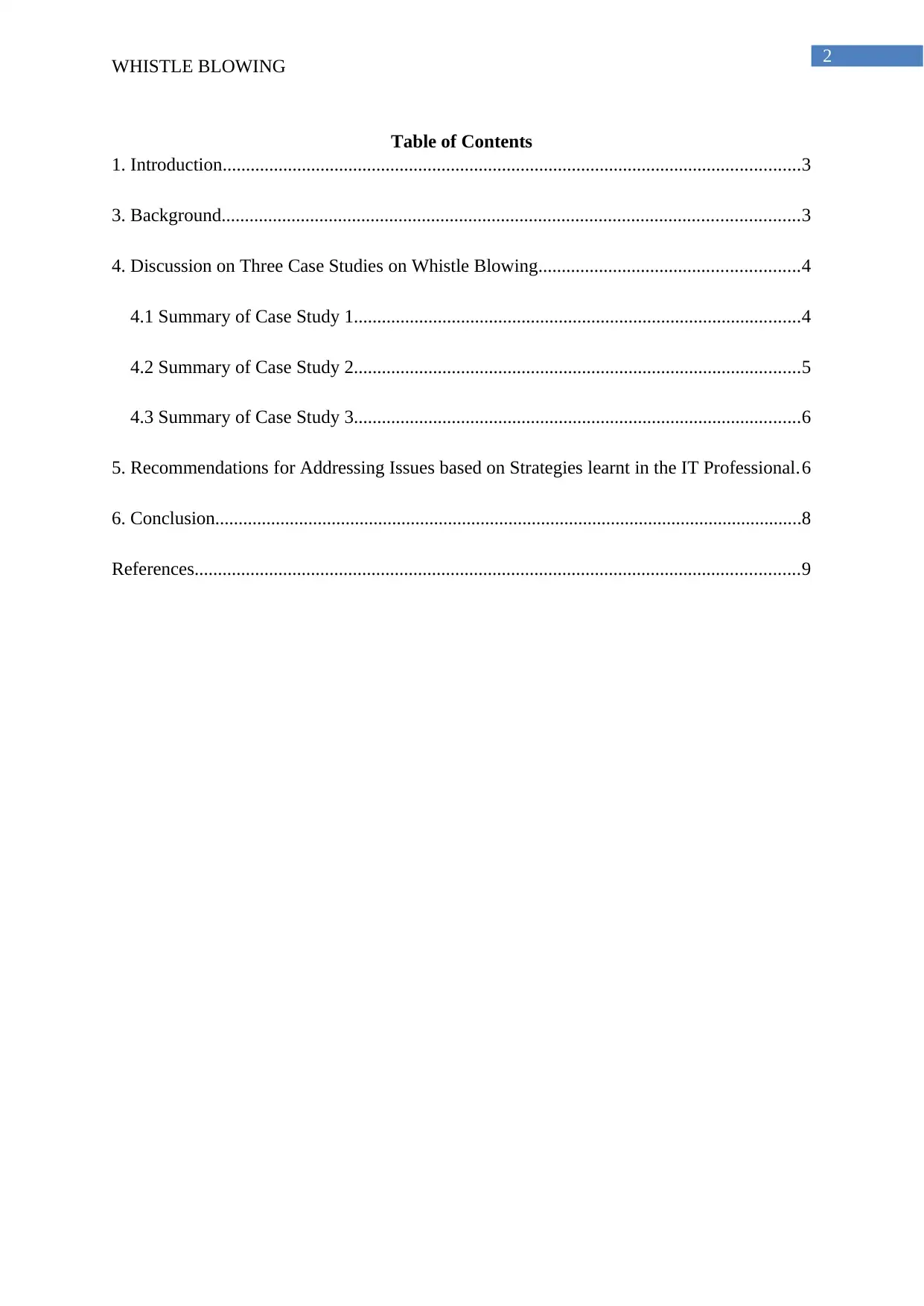
2
WHISTLE BLOWING
Table of Contents
1. Introduction............................................................................................................................3
3. Background............................................................................................................................3
4. Discussion on Three Case Studies on Whistle Blowing........................................................4
4.1 Summary of Case Study 1................................................................................................4
4.2 Summary of Case Study 2................................................................................................5
4.3 Summary of Case Study 3................................................................................................6
5. Recommendations for Addressing Issues based on Strategies learnt in the IT Professional.6
6. Conclusion..............................................................................................................................8
References..................................................................................................................................9
WHISTLE BLOWING
Table of Contents
1. Introduction............................................................................................................................3
3. Background............................................................................................................................3
4. Discussion on Three Case Studies on Whistle Blowing........................................................4
4.1 Summary of Case Study 1................................................................................................4
4.2 Summary of Case Study 2................................................................................................5
4.3 Summary of Case Study 3................................................................................................6
5. Recommendations for Addressing Issues based on Strategies learnt in the IT Professional.6
6. Conclusion..............................................................................................................................8
References..................................................................................................................................9
⊘ This is a preview!⊘
Do you want full access?
Subscribe today to unlock all pages.

Trusted by 1+ million students worldwide
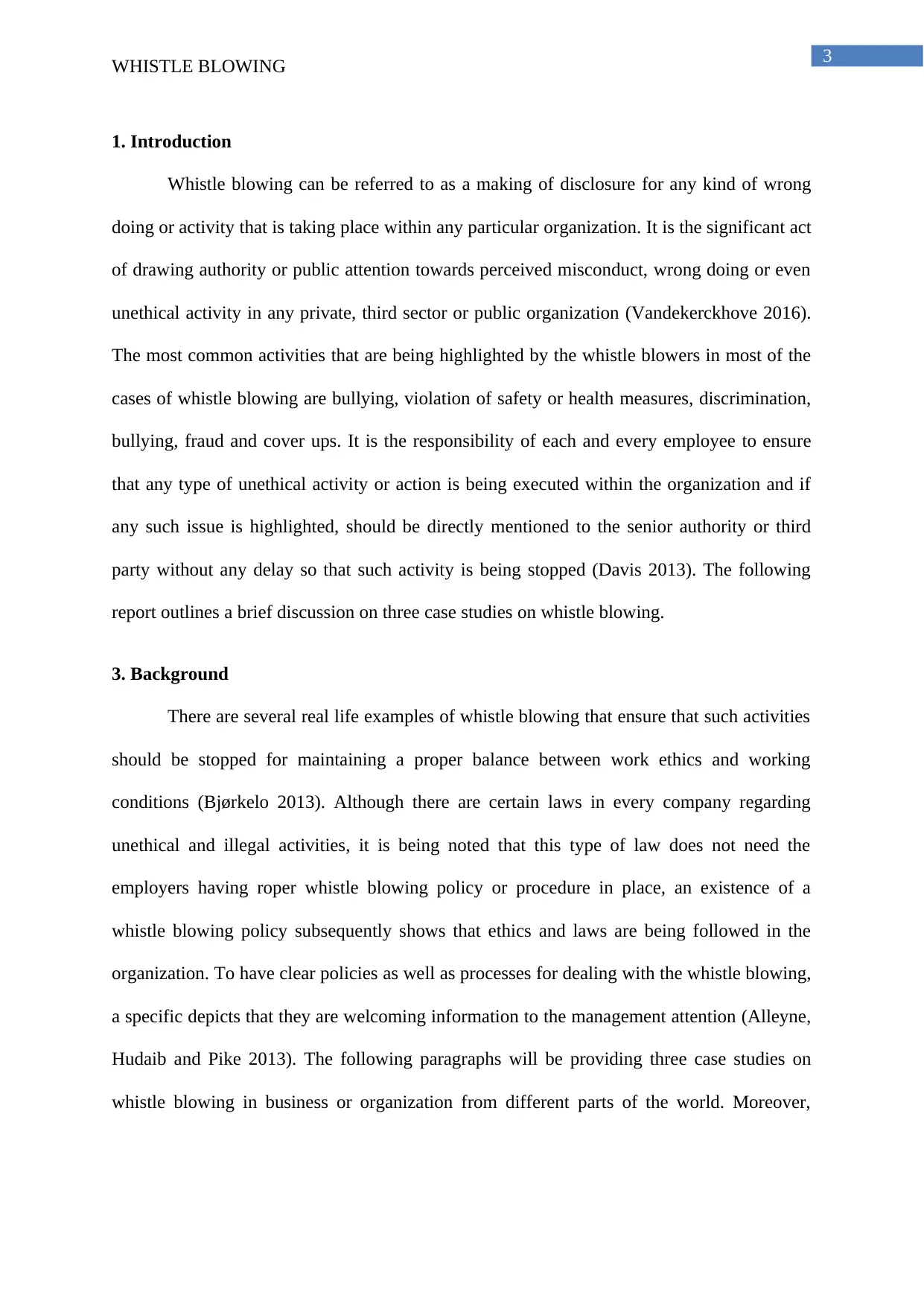
3
WHISTLE BLOWING
1. Introduction
Whistle blowing can be referred to as a making of disclosure for any kind of wrong
doing or activity that is taking place within any particular organization. It is the significant act
of drawing authority or public attention towards perceived misconduct, wrong doing or even
unethical activity in any private, third sector or public organization (Vandekerckhove 2016).
The most common activities that are being highlighted by the whistle blowers in most of the
cases of whistle blowing are bullying, violation of safety or health measures, discrimination,
bullying, fraud and cover ups. It is the responsibility of each and every employee to ensure
that any type of unethical activity or action is being executed within the organization and if
any such issue is highlighted, should be directly mentioned to the senior authority or third
party without any delay so that such activity is being stopped (Davis 2013). The following
report outlines a brief discussion on three case studies on whistle blowing.
3. Background
There are several real life examples of whistle blowing that ensure that such activities
should be stopped for maintaining a proper balance between work ethics and working
conditions (Bjørkelo 2013). Although there are certain laws in every company regarding
unethical and illegal activities, it is being noted that this type of law does not need the
employers having roper whistle blowing policy or procedure in place, an existence of a
whistle blowing policy subsequently shows that ethics and laws are being followed in the
organization. To have clear policies as well as processes for dealing with the whistle blowing,
a specific depicts that they are welcoming information to the management attention (Alleyne,
Hudaib and Pike 2013). The following paragraphs will be providing three case studies on
whistle blowing in business or organization from different parts of the world. Moreover,
WHISTLE BLOWING
1. Introduction
Whistle blowing can be referred to as a making of disclosure for any kind of wrong
doing or activity that is taking place within any particular organization. It is the significant act
of drawing authority or public attention towards perceived misconduct, wrong doing or even
unethical activity in any private, third sector or public organization (Vandekerckhove 2016).
The most common activities that are being highlighted by the whistle blowers in most of the
cases of whistle blowing are bullying, violation of safety or health measures, discrimination,
bullying, fraud and cover ups. It is the responsibility of each and every employee to ensure
that any type of unethical activity or action is being executed within the organization and if
any such issue is highlighted, should be directly mentioned to the senior authority or third
party without any delay so that such activity is being stopped (Davis 2013). The following
report outlines a brief discussion on three case studies on whistle blowing.
3. Background
There are several real life examples of whistle blowing that ensure that such activities
should be stopped for maintaining a proper balance between work ethics and working
conditions (Bjørkelo 2013). Although there are certain laws in every company regarding
unethical and illegal activities, it is being noted that this type of law does not need the
employers having roper whistle blowing policy or procedure in place, an existence of a
whistle blowing policy subsequently shows that ethics and laws are being followed in the
organization. To have clear policies as well as processes for dealing with the whistle blowing,
a specific depicts that they are welcoming information to the management attention (Alleyne,
Hudaib and Pike 2013). The following paragraphs will be providing three case studies on
whistle blowing in business or organization from different parts of the world. Moreover,
Paraphrase This Document
Need a fresh take? Get an instant paraphrase of this document with our AI Paraphraser
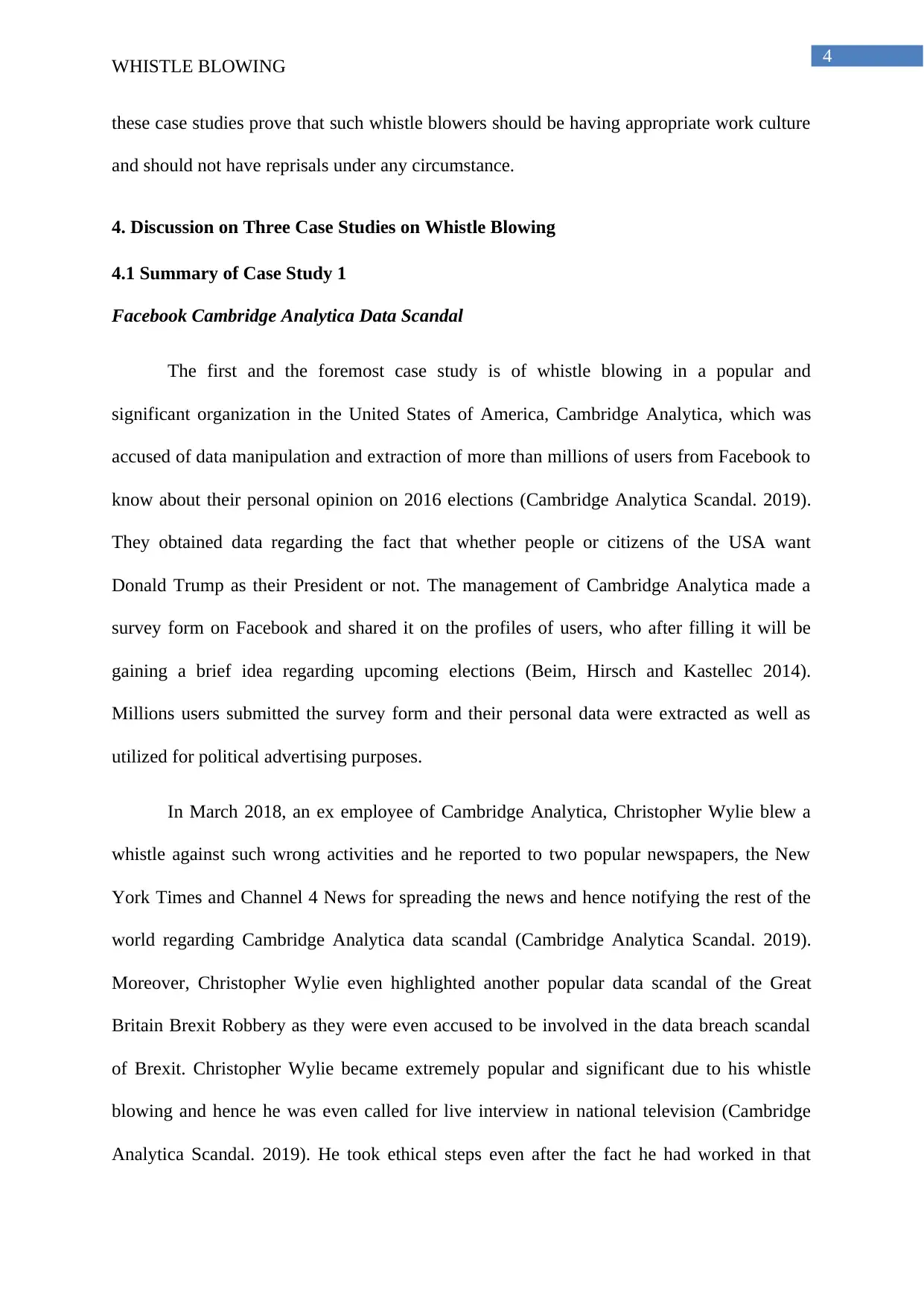
4
WHISTLE BLOWING
these case studies prove that such whistle blowers should be having appropriate work culture
and should not have reprisals under any circumstance.
4. Discussion on Three Case Studies on Whistle Blowing
4.1 Summary of Case Study 1
Facebook Cambridge Analytica Data Scandal
The first and the foremost case study is of whistle blowing in a popular and
significant organization in the United States of America, Cambridge Analytica, which was
accused of data manipulation and extraction of more than millions of users from Facebook to
know about their personal opinion on 2016 elections (Cambridge Analytica Scandal. 2019).
They obtained data regarding the fact that whether people or citizens of the USA want
Donald Trump as their President or not. The management of Cambridge Analytica made a
survey form on Facebook and shared it on the profiles of users, who after filling it will be
gaining a brief idea regarding upcoming elections (Beim, Hirsch and Kastellec 2014).
Millions users submitted the survey form and their personal data were extracted as well as
utilized for political advertising purposes.
In March 2018, an ex employee of Cambridge Analytica, Christopher Wylie blew a
whistle against such wrong activities and he reported to two popular newspapers, the New
York Times and Channel 4 News for spreading the news and hence notifying the rest of the
world regarding Cambridge Analytica data scandal (Cambridge Analytica Scandal. 2019).
Moreover, Christopher Wylie even highlighted another popular data scandal of the Great
Britain Brexit Robbery as they were even accused to be involved in the data breach scandal
of Brexit. Christopher Wylie became extremely popular and significant due to his whistle
blowing and hence he was even called for live interview in national television (Cambridge
Analytica Scandal. 2019). He took ethical steps even after the fact he had worked in that
WHISTLE BLOWING
these case studies prove that such whistle blowers should be having appropriate work culture
and should not have reprisals under any circumstance.
4. Discussion on Three Case Studies on Whistle Blowing
4.1 Summary of Case Study 1
Facebook Cambridge Analytica Data Scandal
The first and the foremost case study is of whistle blowing in a popular and
significant organization in the United States of America, Cambridge Analytica, which was
accused of data manipulation and extraction of more than millions of users from Facebook to
know about their personal opinion on 2016 elections (Cambridge Analytica Scandal. 2019).
They obtained data regarding the fact that whether people or citizens of the USA want
Donald Trump as their President or not. The management of Cambridge Analytica made a
survey form on Facebook and shared it on the profiles of users, who after filling it will be
gaining a brief idea regarding upcoming elections (Beim, Hirsch and Kastellec 2014).
Millions users submitted the survey form and their personal data were extracted as well as
utilized for political advertising purposes.
In March 2018, an ex employee of Cambridge Analytica, Christopher Wylie blew a
whistle against such wrong activities and he reported to two popular newspapers, the New
York Times and Channel 4 News for spreading the news and hence notifying the rest of the
world regarding Cambridge Analytica data scandal (Cambridge Analytica Scandal. 2019).
Moreover, Christopher Wylie even highlighted another popular data scandal of the Great
Britain Brexit Robbery as they were even accused to be involved in the data breach scandal
of Brexit. Christopher Wylie became extremely popular and significant due to his whistle
blowing and hence he was even called for live interview in national television (Cambridge
Analytica Scandal. 2019). He took ethical steps even after the fact he had worked in that
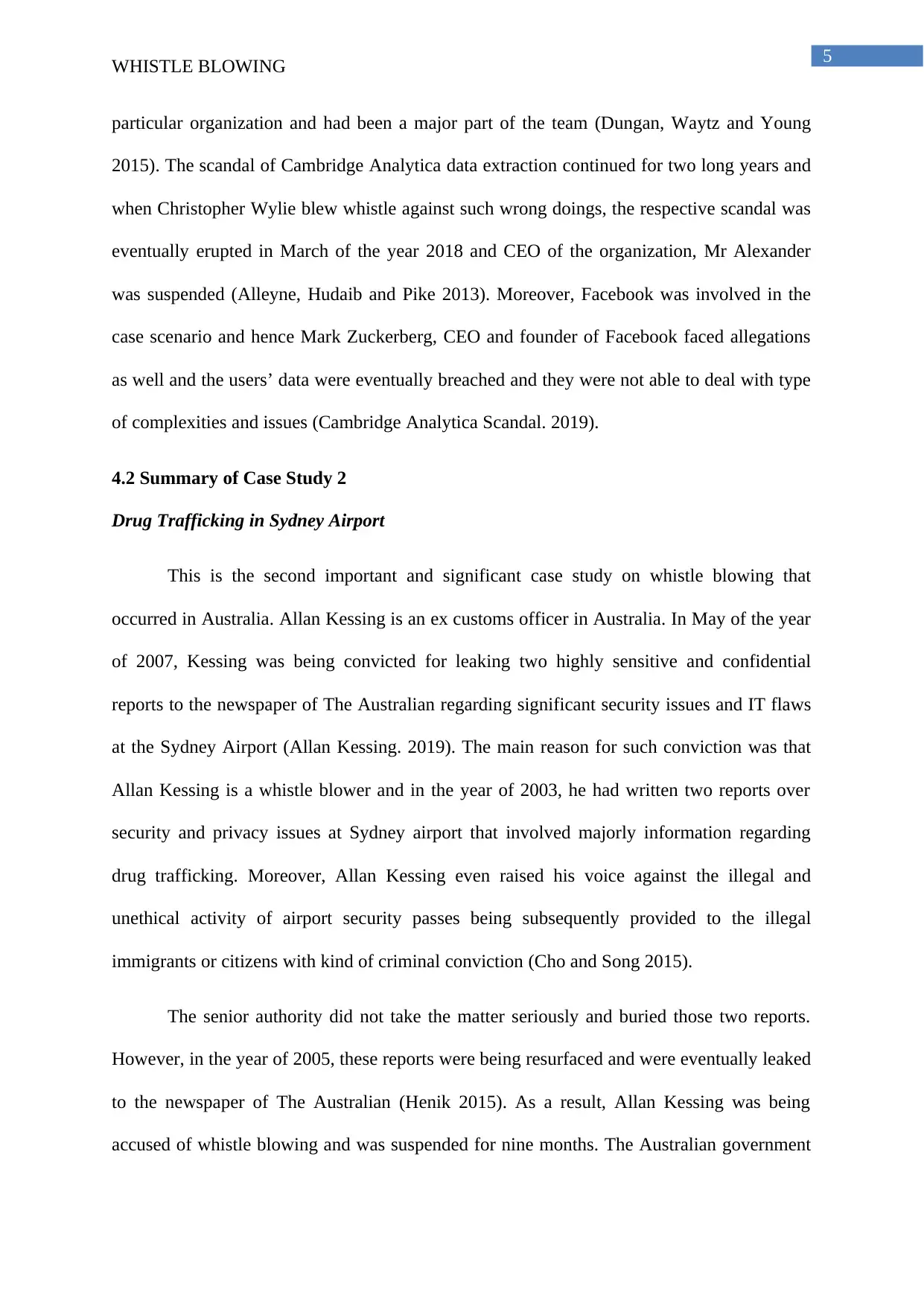
5
WHISTLE BLOWING
particular organization and had been a major part of the team (Dungan, Waytz and Young
2015). The scandal of Cambridge Analytica data extraction continued for two long years and
when Christopher Wylie blew whistle against such wrong doings, the respective scandal was
eventually erupted in March of the year 2018 and CEO of the organization, Mr Alexander
was suspended (Alleyne, Hudaib and Pike 2013). Moreover, Facebook was involved in the
case scenario and hence Mark Zuckerberg, CEO and founder of Facebook faced allegations
as well and the users’ data were eventually breached and they were not able to deal with type
of complexities and issues (Cambridge Analytica Scandal. 2019).
4.2 Summary of Case Study 2
Drug Trafficking in Sydney Airport
This is the second important and significant case study on whistle blowing that
occurred in Australia. Allan Kessing is an ex customs officer in Australia. In May of the year
of 2007, Kessing was being convicted for leaking two highly sensitive and confidential
reports to the newspaper of The Australian regarding significant security issues and IT flaws
at the Sydney Airport (Allan Kessing. 2019). The main reason for such conviction was that
Allan Kessing is a whistle blower and in the year of 2003, he had written two reports over
security and privacy issues at Sydney airport that involved majorly information regarding
drug trafficking. Moreover, Allan Kessing even raised his voice against the illegal and
unethical activity of airport security passes being subsequently provided to the illegal
immigrants or citizens with kind of criminal conviction (Cho and Song 2015).
The senior authority did not take the matter seriously and buried those two reports.
However, in the year of 2005, these reports were being resurfaced and were eventually leaked
to the newspaper of The Australian (Henik 2015). As a result, Allan Kessing was being
accused of whistle blowing and was suspended for nine months. The Australian government
WHISTLE BLOWING
particular organization and had been a major part of the team (Dungan, Waytz and Young
2015). The scandal of Cambridge Analytica data extraction continued for two long years and
when Christopher Wylie blew whistle against such wrong doings, the respective scandal was
eventually erupted in March of the year 2018 and CEO of the organization, Mr Alexander
was suspended (Alleyne, Hudaib and Pike 2013). Moreover, Facebook was involved in the
case scenario and hence Mark Zuckerberg, CEO and founder of Facebook faced allegations
as well and the users’ data were eventually breached and they were not able to deal with type
of complexities and issues (Cambridge Analytica Scandal. 2019).
4.2 Summary of Case Study 2
Drug Trafficking in Sydney Airport
This is the second important and significant case study on whistle blowing that
occurred in Australia. Allan Kessing is an ex customs officer in Australia. In May of the year
of 2007, Kessing was being convicted for leaking two highly sensitive and confidential
reports to the newspaper of The Australian regarding significant security issues and IT flaws
at the Sydney Airport (Allan Kessing. 2019). The main reason for such conviction was that
Allan Kessing is a whistle blower and in the year of 2003, he had written two reports over
security and privacy issues at Sydney airport that involved majorly information regarding
drug trafficking. Moreover, Allan Kessing even raised his voice against the illegal and
unethical activity of airport security passes being subsequently provided to the illegal
immigrants or citizens with kind of criminal conviction (Cho and Song 2015).
The senior authority did not take the matter seriously and buried those two reports.
However, in the year of 2005, these reports were being resurfaced and were eventually leaked
to the newspaper of The Australian (Henik 2015). As a result, Allan Kessing was being
accused of whistle blowing and was suspended for nine months. The Australian government
⊘ This is a preview!⊘
Do you want full access?
Subscribe today to unlock all pages.

Trusted by 1+ million students worldwide
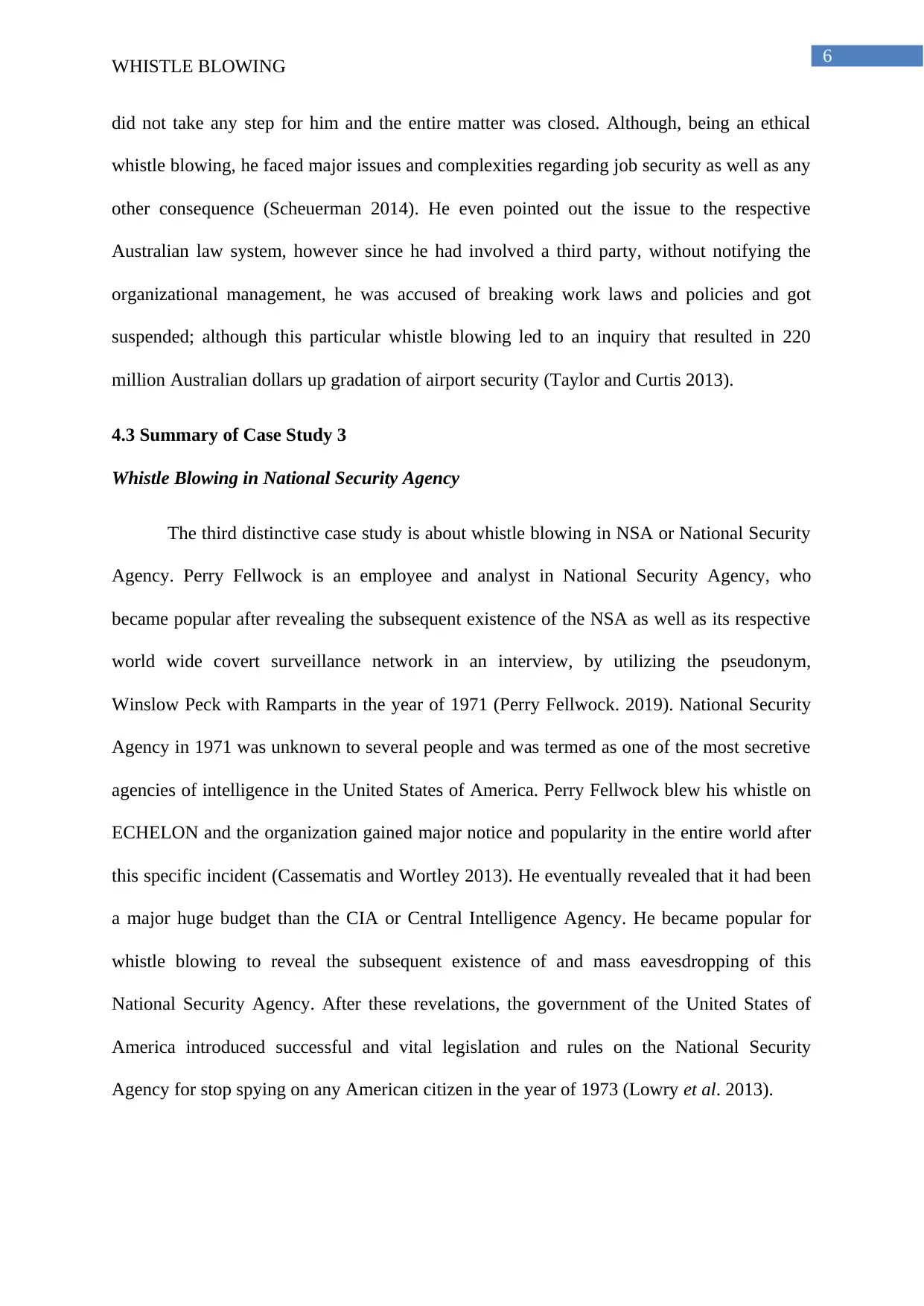
6
WHISTLE BLOWING
did not take any step for him and the entire matter was closed. Although, being an ethical
whistle blowing, he faced major issues and complexities regarding job security as well as any
other consequence (Scheuerman 2014). He even pointed out the issue to the respective
Australian law system, however since he had involved a third party, without notifying the
organizational management, he was accused of breaking work laws and policies and got
suspended; although this particular whistle blowing led to an inquiry that resulted in 220
million Australian dollars up gradation of airport security (Taylor and Curtis 2013).
4.3 Summary of Case Study 3
Whistle Blowing in National Security Agency
The third distinctive case study is about whistle blowing in NSA or National Security
Agency. Perry Fellwock is an employee and analyst in National Security Agency, who
became popular after revealing the subsequent existence of the NSA as well as its respective
world wide covert surveillance network in an interview, by utilizing the pseudonym,
Winslow Peck with Ramparts in the year of 1971 (Perry Fellwock. 2019). National Security
Agency in 1971 was unknown to several people and was termed as one of the most secretive
agencies of intelligence in the United States of America. Perry Fellwock blew his whistle on
ECHELON and the organization gained major notice and popularity in the entire world after
this specific incident (Cassematis and Wortley 2013). He eventually revealed that it had been
a major huge budget than the CIA or Central Intelligence Agency. He became popular for
whistle blowing to reveal the subsequent existence of and mass eavesdropping of this
National Security Agency. After these revelations, the government of the United States of
America introduced successful and vital legislation and rules on the National Security
Agency for stop spying on any American citizen in the year of 1973 (Lowry et al. 2013).
WHISTLE BLOWING
did not take any step for him and the entire matter was closed. Although, being an ethical
whistle blowing, he faced major issues and complexities regarding job security as well as any
other consequence (Scheuerman 2014). He even pointed out the issue to the respective
Australian law system, however since he had involved a third party, without notifying the
organizational management, he was accused of breaking work laws and policies and got
suspended; although this particular whistle blowing led to an inquiry that resulted in 220
million Australian dollars up gradation of airport security (Taylor and Curtis 2013).
4.3 Summary of Case Study 3
Whistle Blowing in National Security Agency
The third distinctive case study is about whistle blowing in NSA or National Security
Agency. Perry Fellwock is an employee and analyst in National Security Agency, who
became popular after revealing the subsequent existence of the NSA as well as its respective
world wide covert surveillance network in an interview, by utilizing the pseudonym,
Winslow Peck with Ramparts in the year of 1971 (Perry Fellwock. 2019). National Security
Agency in 1971 was unknown to several people and was termed as one of the most secretive
agencies of intelligence in the United States of America. Perry Fellwock blew his whistle on
ECHELON and the organization gained major notice and popularity in the entire world after
this specific incident (Cassematis and Wortley 2013). He eventually revealed that it had been
a major huge budget than the CIA or Central Intelligence Agency. He became popular for
whistle blowing to reveal the subsequent existence of and mass eavesdropping of this
National Security Agency. After these revelations, the government of the United States of
America introduced successful and vital legislation and rules on the National Security
Agency for stop spying on any American citizen in the year of 1973 (Lowry et al. 2013).
Paraphrase This Document
Need a fresh take? Get an instant paraphrase of this document with our AI Paraphraser
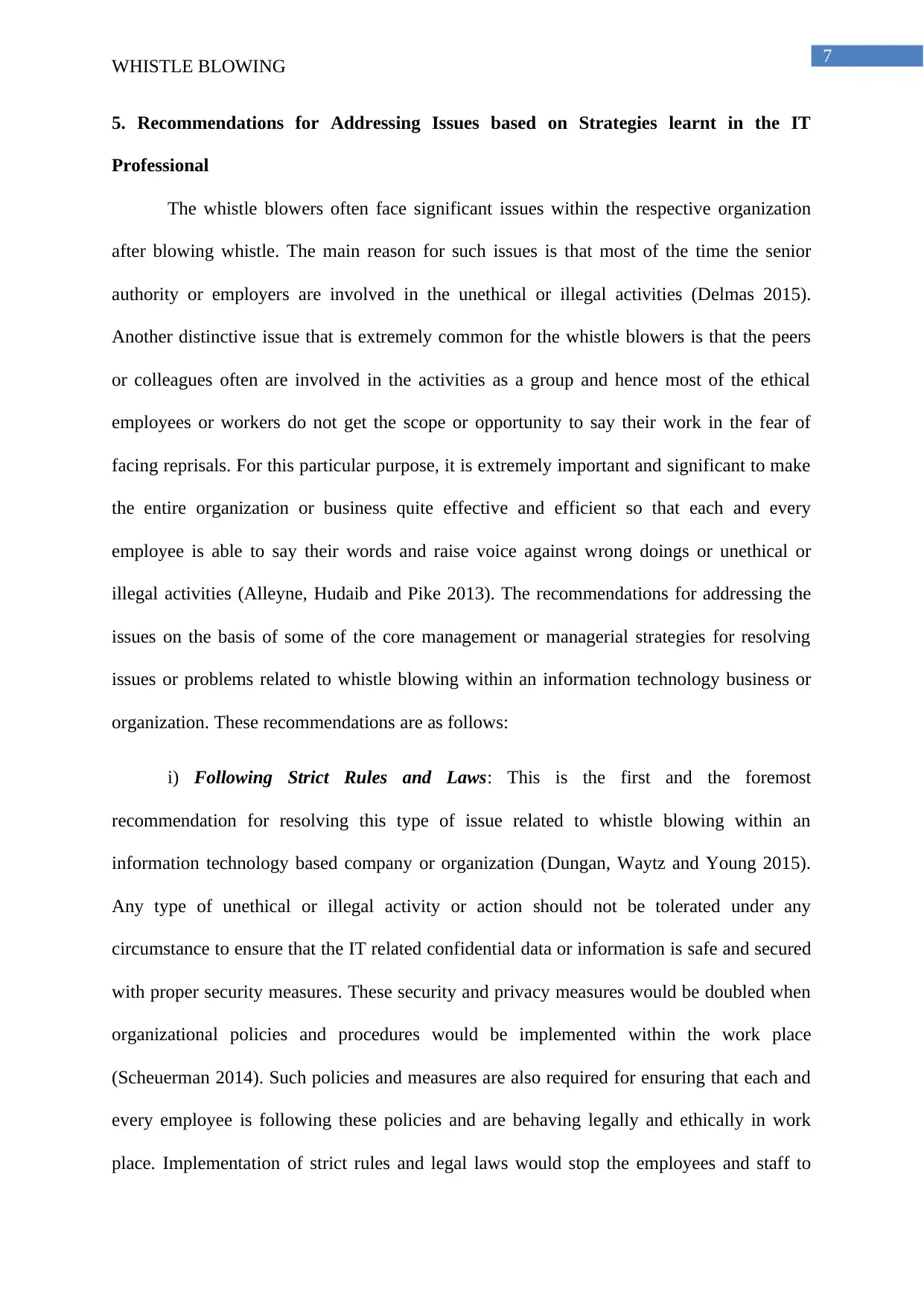
7
WHISTLE BLOWING
5. Recommendations for Addressing Issues based on Strategies learnt in the IT
Professional
The whistle blowers often face significant issues within the respective organization
after blowing whistle. The main reason for such issues is that most of the time the senior
authority or employers are involved in the unethical or illegal activities (Delmas 2015).
Another distinctive issue that is extremely common for the whistle blowers is that the peers
or colleagues often are involved in the activities as a group and hence most of the ethical
employees or workers do not get the scope or opportunity to say their work in the fear of
facing reprisals. For this particular purpose, it is extremely important and significant to make
the entire organization or business quite effective and efficient so that each and every
employee is able to say their words and raise voice against wrong doings or unethical or
illegal activities (Alleyne, Hudaib and Pike 2013). The recommendations for addressing the
issues on the basis of some of the core management or managerial strategies for resolving
issues or problems related to whistle blowing within an information technology business or
organization. These recommendations are as follows:
i) Following Strict Rules and Laws: This is the first and the foremost
recommendation for resolving this type of issue related to whistle blowing within an
information technology based company or organization (Dungan, Waytz and Young 2015).
Any type of unethical or illegal activity or action should not be tolerated under any
circumstance to ensure that the IT related confidential data or information is safe and secured
with proper security measures. These security and privacy measures would be doubled when
organizational policies and procedures would be implemented within the work place
(Scheuerman 2014). Such policies and measures are also required for ensuring that each and
every employee is following these policies and are behaving legally and ethically in work
place. Implementation of strict rules and legal laws would stop the employees and staff to
WHISTLE BLOWING
5. Recommendations for Addressing Issues based on Strategies learnt in the IT
Professional
The whistle blowers often face significant issues within the respective organization
after blowing whistle. The main reason for such issues is that most of the time the senior
authority or employers are involved in the unethical or illegal activities (Delmas 2015).
Another distinctive issue that is extremely common for the whistle blowers is that the peers
or colleagues often are involved in the activities as a group and hence most of the ethical
employees or workers do not get the scope or opportunity to say their work in the fear of
facing reprisals. For this particular purpose, it is extremely important and significant to make
the entire organization or business quite effective and efficient so that each and every
employee is able to say their words and raise voice against wrong doings or unethical or
illegal activities (Alleyne, Hudaib and Pike 2013). The recommendations for addressing the
issues on the basis of some of the core management or managerial strategies for resolving
issues or problems related to whistle blowing within an information technology business or
organization. These recommendations are as follows:
i) Following Strict Rules and Laws: This is the first and the foremost
recommendation for resolving this type of issue related to whistle blowing within an
information technology based company or organization (Dungan, Waytz and Young 2015).
Any type of unethical or illegal activity or action should not be tolerated under any
circumstance to ensure that the IT related confidential data or information is safe and secured
with proper security measures. These security and privacy measures would be doubled when
organizational policies and procedures would be implemented within the work place
(Scheuerman 2014). Such policies and measures are also required for ensuring that each and
every employee is following these policies and are behaving legally and ethically in work
place. Implementation of strict rules and legal laws would stop the employees and staff to
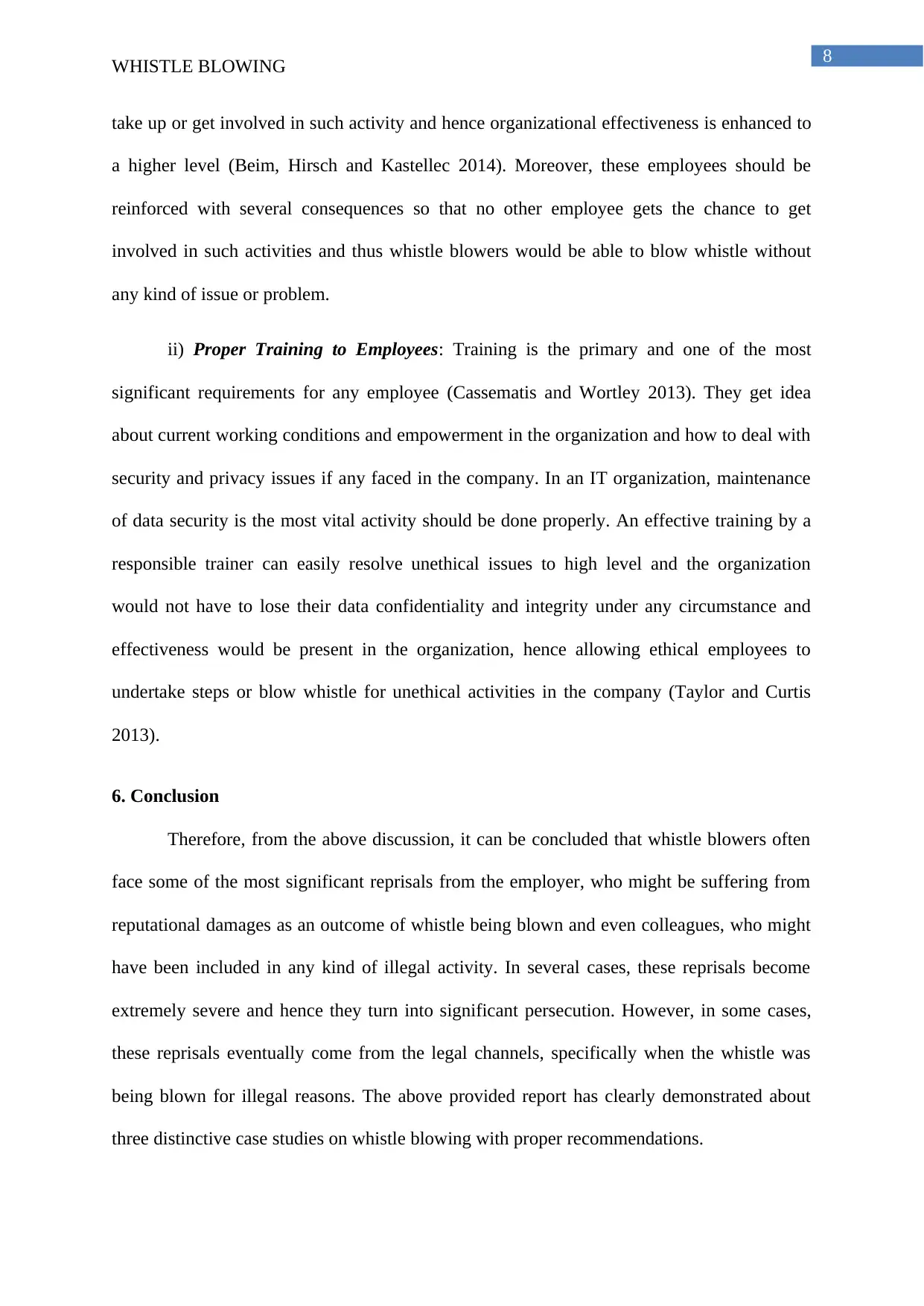
8
WHISTLE BLOWING
take up or get involved in such activity and hence organizational effectiveness is enhanced to
a higher level (Beim, Hirsch and Kastellec 2014). Moreover, these employees should be
reinforced with several consequences so that no other employee gets the chance to get
involved in such activities and thus whistle blowers would be able to blow whistle without
any kind of issue or problem.
ii) Proper Training to Employees: Training is the primary and one of the most
significant requirements for any employee (Cassematis and Wortley 2013). They get idea
about current working conditions and empowerment in the organization and how to deal with
security and privacy issues if any faced in the company. In an IT organization, maintenance
of data security is the most vital activity should be done properly. An effective training by a
responsible trainer can easily resolve unethical issues to high level and the organization
would not have to lose their data confidentiality and integrity under any circumstance and
effectiveness would be present in the organization, hence allowing ethical employees to
undertake steps or blow whistle for unethical activities in the company (Taylor and Curtis
2013).
6. Conclusion
Therefore, from the above discussion, it can be concluded that whistle blowers often
face some of the most significant reprisals from the employer, who might be suffering from
reputational damages as an outcome of whistle being blown and even colleagues, who might
have been included in any kind of illegal activity. In several cases, these reprisals become
extremely severe and hence they turn into significant persecution. However, in some cases,
these reprisals eventually come from the legal channels, specifically when the whistle was
being blown for illegal reasons. The above provided report has clearly demonstrated about
three distinctive case studies on whistle blowing with proper recommendations.
WHISTLE BLOWING
take up or get involved in such activity and hence organizational effectiveness is enhanced to
a higher level (Beim, Hirsch and Kastellec 2014). Moreover, these employees should be
reinforced with several consequences so that no other employee gets the chance to get
involved in such activities and thus whistle blowers would be able to blow whistle without
any kind of issue or problem.
ii) Proper Training to Employees: Training is the primary and one of the most
significant requirements for any employee (Cassematis and Wortley 2013). They get idea
about current working conditions and empowerment in the organization and how to deal with
security and privacy issues if any faced in the company. In an IT organization, maintenance
of data security is the most vital activity should be done properly. An effective training by a
responsible trainer can easily resolve unethical issues to high level and the organization
would not have to lose their data confidentiality and integrity under any circumstance and
effectiveness would be present in the organization, hence allowing ethical employees to
undertake steps or blow whistle for unethical activities in the company (Taylor and Curtis
2013).
6. Conclusion
Therefore, from the above discussion, it can be concluded that whistle blowers often
face some of the most significant reprisals from the employer, who might be suffering from
reputational damages as an outcome of whistle being blown and even colleagues, who might
have been included in any kind of illegal activity. In several cases, these reprisals become
extremely severe and hence they turn into significant persecution. However, in some cases,
these reprisals eventually come from the legal channels, specifically when the whistle was
being blown for illegal reasons. The above provided report has clearly demonstrated about
three distinctive case studies on whistle blowing with proper recommendations.
⊘ This is a preview!⊘
Do you want full access?
Subscribe today to unlock all pages.

Trusted by 1+ million students worldwide
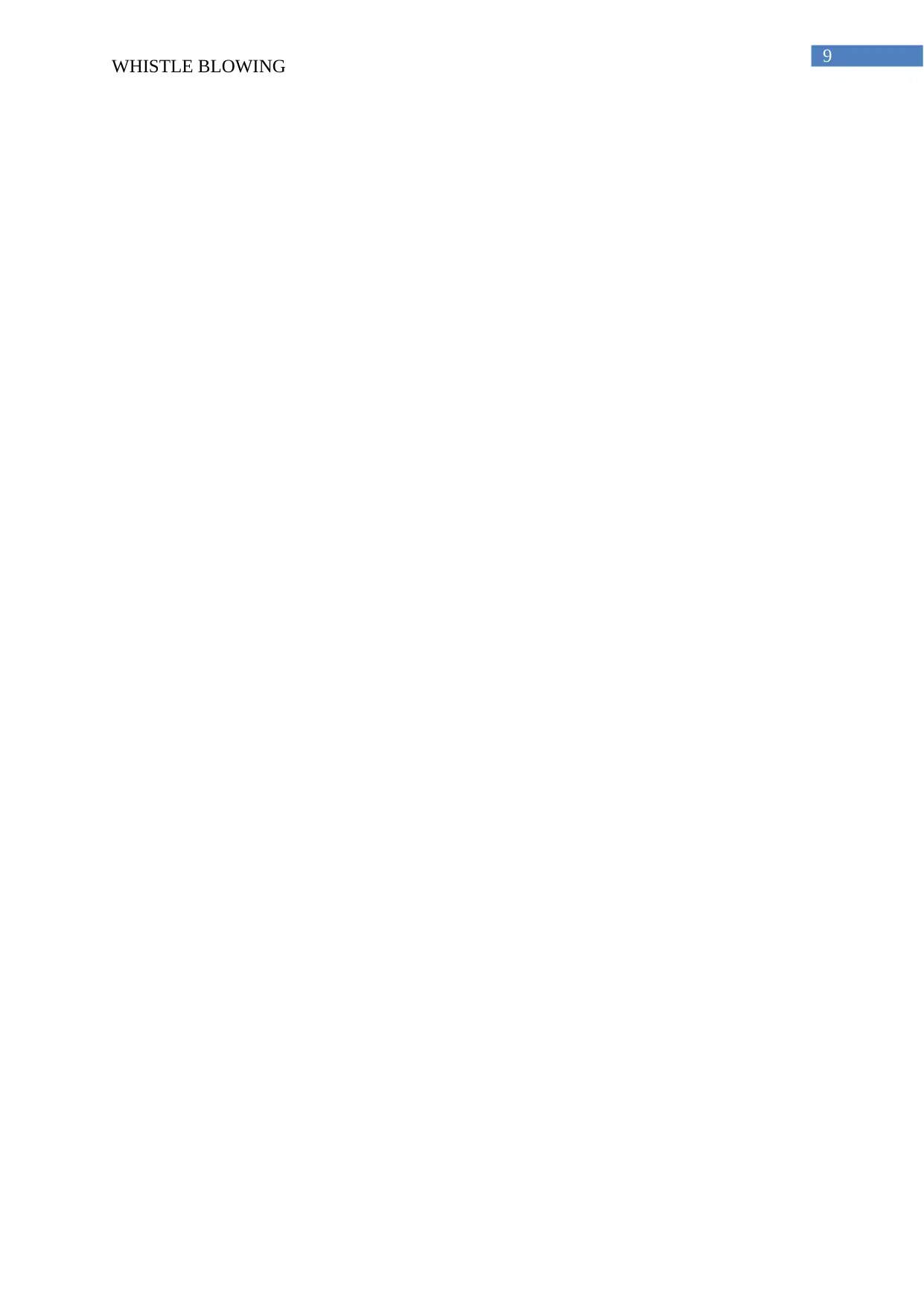
9
WHISTLE BLOWING
WHISTLE BLOWING
Paraphrase This Document
Need a fresh take? Get an instant paraphrase of this document with our AI Paraphraser
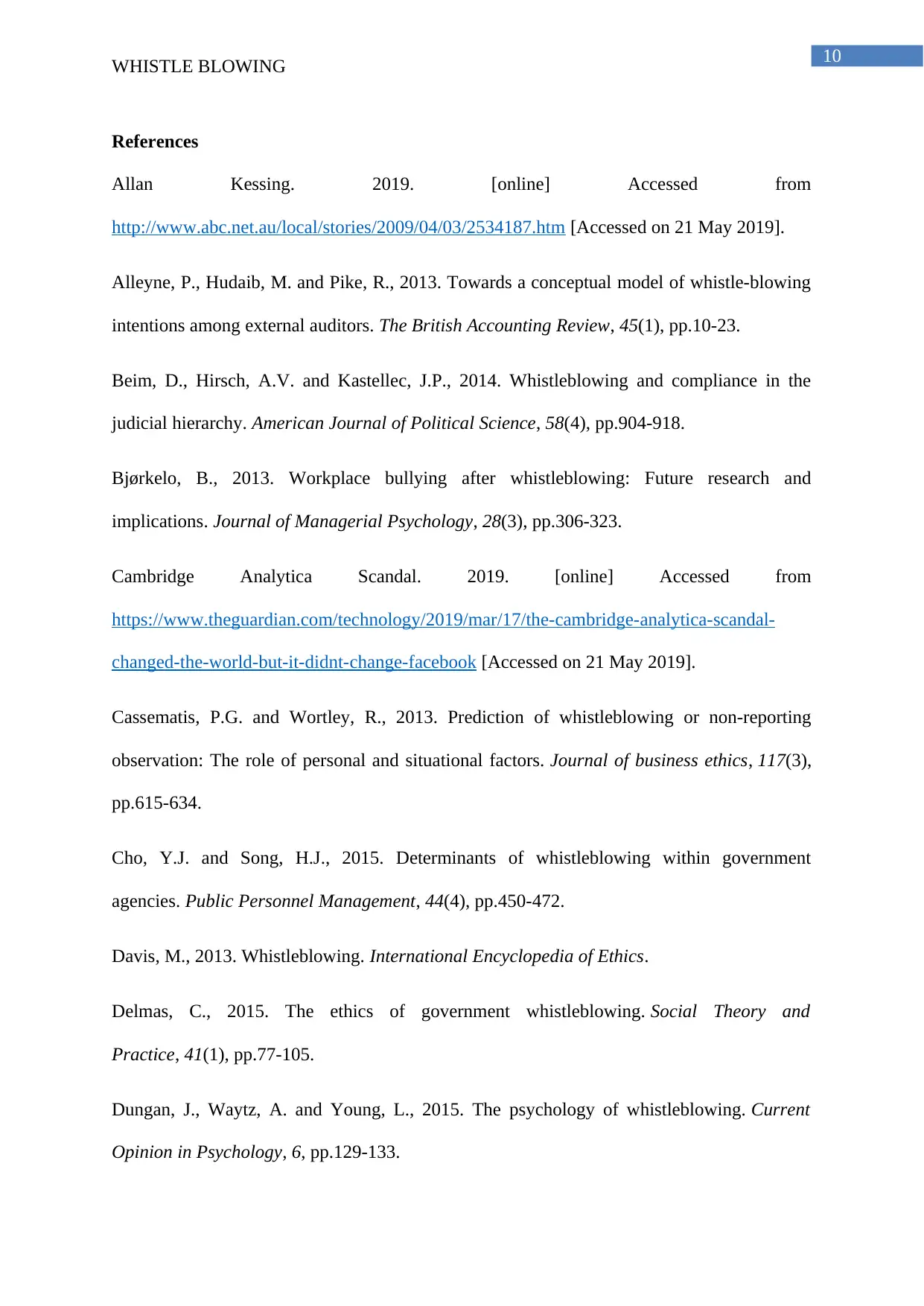
10
WHISTLE BLOWING
References
Allan Kessing. 2019. [online] Accessed from
http://www.abc.net.au/local/stories/2009/04/03/2534187.htm [Accessed on 21 May 2019].
Alleyne, P., Hudaib, M. and Pike, R., 2013. Towards a conceptual model of whistle-blowing
intentions among external auditors. The British Accounting Review, 45(1), pp.10-23.
Beim, D., Hirsch, A.V. and Kastellec, J.P., 2014. Whistleblowing and compliance in the
judicial hierarchy. American Journal of Political Science, 58(4), pp.904-918.
Bjørkelo, B., 2013. Workplace bullying after whistleblowing: Future research and
implications. Journal of Managerial Psychology, 28(3), pp.306-323.
Cambridge Analytica Scandal. 2019. [online] Accessed from
https://www.theguardian.com/technology/2019/mar/17/the-cambridge-analytica-scandal-
changed-the-world-but-it-didnt-change-facebook [Accessed on 21 May 2019].
Cassematis, P.G. and Wortley, R., 2013. Prediction of whistleblowing or non-reporting
observation: The role of personal and situational factors. Journal of business ethics, 117(3),
pp.615-634.
Cho, Y.J. and Song, H.J., 2015. Determinants of whistleblowing within government
agencies. Public Personnel Management, 44(4), pp.450-472.
Davis, M., 2013. Whistleblowing. International Encyclopedia of Ethics.
Delmas, C., 2015. The ethics of government whistleblowing. Social Theory and
Practice, 41(1), pp.77-105.
Dungan, J., Waytz, A. and Young, L., 2015. The psychology of whistleblowing. Current
Opinion in Psychology, 6, pp.129-133.
WHISTLE BLOWING
References
Allan Kessing. 2019. [online] Accessed from
http://www.abc.net.au/local/stories/2009/04/03/2534187.htm [Accessed on 21 May 2019].
Alleyne, P., Hudaib, M. and Pike, R., 2013. Towards a conceptual model of whistle-blowing
intentions among external auditors. The British Accounting Review, 45(1), pp.10-23.
Beim, D., Hirsch, A.V. and Kastellec, J.P., 2014. Whistleblowing and compliance in the
judicial hierarchy. American Journal of Political Science, 58(4), pp.904-918.
Bjørkelo, B., 2013. Workplace bullying after whistleblowing: Future research and
implications. Journal of Managerial Psychology, 28(3), pp.306-323.
Cambridge Analytica Scandal. 2019. [online] Accessed from
https://www.theguardian.com/technology/2019/mar/17/the-cambridge-analytica-scandal-
changed-the-world-but-it-didnt-change-facebook [Accessed on 21 May 2019].
Cassematis, P.G. and Wortley, R., 2013. Prediction of whistleblowing or non-reporting
observation: The role of personal and situational factors. Journal of business ethics, 117(3),
pp.615-634.
Cho, Y.J. and Song, H.J., 2015. Determinants of whistleblowing within government
agencies. Public Personnel Management, 44(4), pp.450-472.
Davis, M., 2013. Whistleblowing. International Encyclopedia of Ethics.
Delmas, C., 2015. The ethics of government whistleblowing. Social Theory and
Practice, 41(1), pp.77-105.
Dungan, J., Waytz, A. and Young, L., 2015. The psychology of whistleblowing. Current
Opinion in Psychology, 6, pp.129-133.
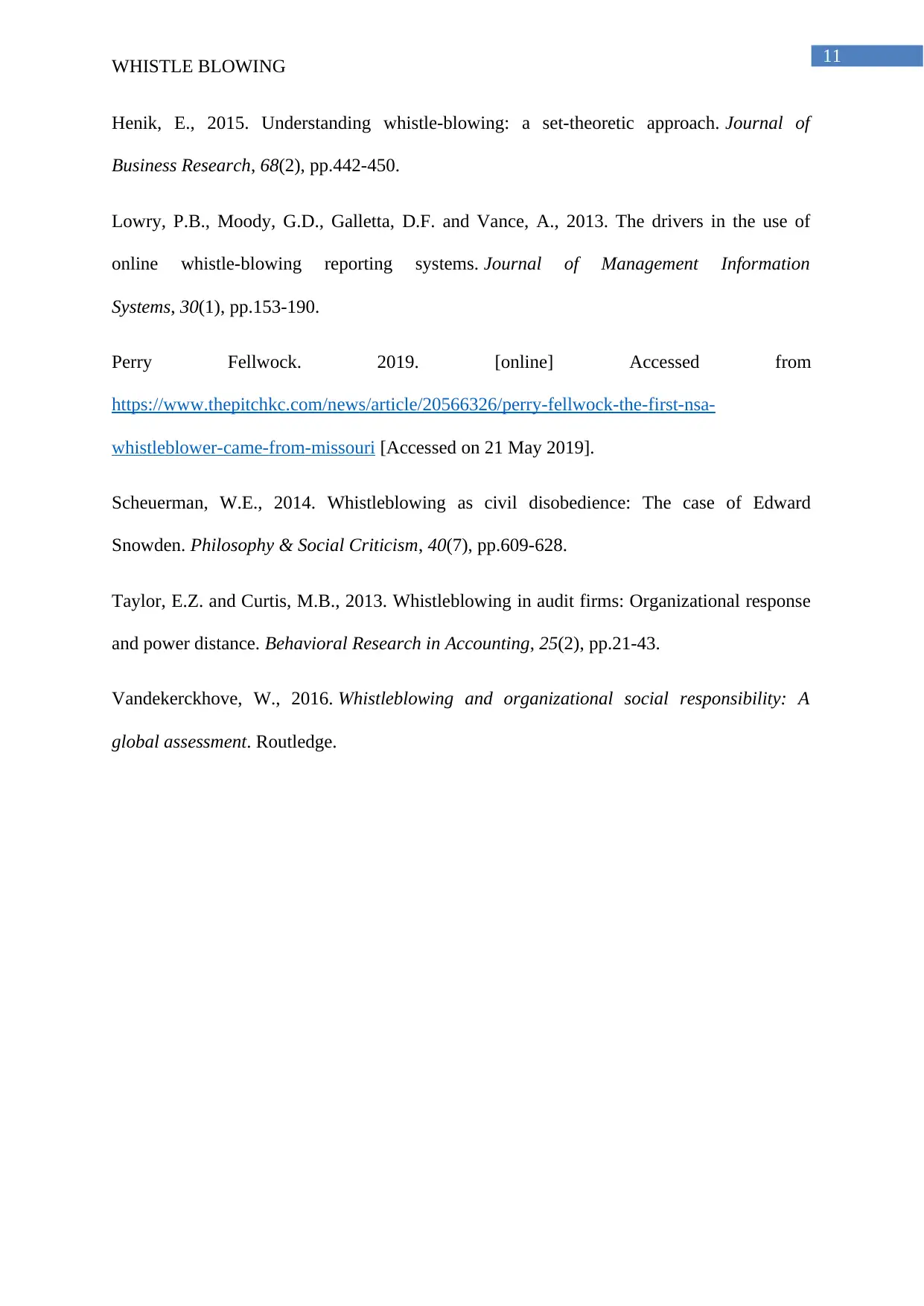
11
WHISTLE BLOWING
Henik, E., 2015. Understanding whistle-blowing: a set-theoretic approach. Journal of
Business Research, 68(2), pp.442-450.
Lowry, P.B., Moody, G.D., Galletta, D.F. and Vance, A., 2013. The drivers in the use of
online whistle-blowing reporting systems. Journal of Management Information
Systems, 30(1), pp.153-190.
Perry Fellwock. 2019. [online] Accessed from
https://www.thepitchkc.com/news/article/20566326/perry-fellwock-the-first-nsa-
whistleblower-came-from-missouri [Accessed on 21 May 2019].
Scheuerman, W.E., 2014. Whistleblowing as civil disobedience: The case of Edward
Snowden. Philosophy & Social Criticism, 40(7), pp.609-628.
Taylor, E.Z. and Curtis, M.B., 2013. Whistleblowing in audit firms: Organizational response
and power distance. Behavioral Research in Accounting, 25(2), pp.21-43.
Vandekerckhove, W., 2016. Whistleblowing and organizational social responsibility: A
global assessment. Routledge.
WHISTLE BLOWING
Henik, E., 2015. Understanding whistle-blowing: a set-theoretic approach. Journal of
Business Research, 68(2), pp.442-450.
Lowry, P.B., Moody, G.D., Galletta, D.F. and Vance, A., 2013. The drivers in the use of
online whistle-blowing reporting systems. Journal of Management Information
Systems, 30(1), pp.153-190.
Perry Fellwock. 2019. [online] Accessed from
https://www.thepitchkc.com/news/article/20566326/perry-fellwock-the-first-nsa-
whistleblower-came-from-missouri [Accessed on 21 May 2019].
Scheuerman, W.E., 2014. Whistleblowing as civil disobedience: The case of Edward
Snowden. Philosophy & Social Criticism, 40(7), pp.609-628.
Taylor, E.Z. and Curtis, M.B., 2013. Whistleblowing in audit firms: Organizational response
and power distance. Behavioral Research in Accounting, 25(2), pp.21-43.
Vandekerckhove, W., 2016. Whistleblowing and organizational social responsibility: A
global assessment. Routledge.
⊘ This is a preview!⊘
Do you want full access?
Subscribe today to unlock all pages.

Trusted by 1+ million students worldwide
1 out of 12
Related Documents
Your All-in-One AI-Powered Toolkit for Academic Success.
+13062052269
info@desklib.com
Available 24*7 on WhatsApp / Email
![[object Object]](/_next/static/media/star-bottom.7253800d.svg)
Unlock your academic potential
Copyright © 2020–2025 A2Z Services. All Rights Reserved. Developed and managed by ZUCOL.





